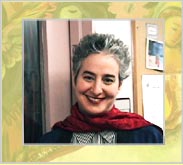 |
|
 |
 I
grew up in New York
City, in a neighborhood near East Harlem where people from many
different countries had come to live and work. My own parents were
born in the United States, but my grandparents immigrated from the
Jewish communities of Russia, Poland and Lithuania. Growing up in
the 50s and 60s, I heard people around me speaking many different
languages — Spanish, Russian, French, Yiddish. I attended public
schools, and as a child, I especially loved reading folktales and
myths. Even as a teenager, I would return to the collections of
fairy tales and folktales at the public library near my home. When
I read a collection of Russian folktales, or Turkish fairy tales,
I felt that I was being given a gift of insight, a window into other
people's culture, history, and worldview. Once, in my senior year
in high school, I turned to my friend Stacey Andreatos, and said,
"Would you like to hear a story?" "Okay," she replied, "tell me
one." And so I told her The Tinder Box, by Hans Christian
Andersen. After I had finished, Stacey called another friend over,
and said, "Nina, tell us another one." Then I understood that stories
were important, not only to read, but to tell, and that people,
even friends my own age, wanted to hear them. I
grew up in New York
City, in a neighborhood near East Harlem where people from many
different countries had come to live and work. My own parents were
born in the United States, but my grandparents immigrated from the
Jewish communities of Russia, Poland and Lithuania. Growing up in
the 50s and 60s, I heard people around me speaking many different
languages — Spanish, Russian, French, Yiddish. I attended public
schools, and as a child, I especially loved reading folktales and
myths. Even as a teenager, I would return to the collections of
fairy tales and folktales at the public library near my home. When
I read a collection of Russian folktales, or Turkish fairy tales,
I felt that I was being given a gift of insight, a window into other
people's culture, history, and worldview. Once, in my senior year
in high school, I turned to my friend Stacey Andreatos, and said,
"Would you like to hear a story?" "Okay," she replied, "tell me
one." And so I told her The Tinder Box, by Hans Christian
Andersen. After I had finished, Stacey called another friend over,
and said, "Nina, tell us another one." Then I understood that stories
were important, not only to read, but to tell, and that people,
even friends my own age, wanted to hear them.
I attended Wesleyan University, where
I played and studied with master musicians from Ghana, south India,
Indonesia, and other parts of the world. I also learned that music
and storytelling were a vital part of many people's continuing way
of life, and were integrally woven into their ritual, beliefs, and
life passages. I slowly began to practice my craft — telling
stories for children in schools and in libraries. It seemed natural
to incorporate the songs and rhythms I was learning with the stories.
Travels to Israel, Puerto Rico, and the Dominican Republic also
gave me a chance to study music and languages — Spanish and
Hebrew. I've played the guitar and piano since childhood. My favorite
instruments to play are hand drums, especially percussion styles
from west Africa, the Caribbean, and the Middle East. Even when
I write, I often think of songs or music to go with the stories.
After college, I pursued a Master's
degree in Bilingual Education, and became a teacher. My work as
a writer began after my son Louis was born. Some book publishers
were interested in stories from the Jewish tradition, and by that
time, I knew many stories. My first book, The Three Riddles,
was published in 1989 and it is still one of my favorites to share
in performance. It is the story of a wise girl named Rachel, and
how she solved some difficult riddles and saved her family. It is
always fascinating to discover that different versions of a story
like this are told all over the world.
By now I have written more than 12
books. Some are picture books, others are story collections; and
one biography, A Voice for the People: The Life and Work of Harold
Courlander — a great folklorist and storyteller. I also
teach courses in storytelling, music, and folklore to graduate students
at Bank Street College of Education in New York City. For me, storytelling
and story writing are a way of connecting; of passing on wisdom,
knowledge, and understanding that have been part of human history
and civilization for many centuries. These stories come through
my own voice, my own imagination, but they are also part of other
people's lives and histories. It's wonderful to think that stories
will continue to be told and retold, as I put them into written
form.
To learn more, read a transcript of a discussion between Nina Jaffe and Scholastic.com students.
|
 |
 |